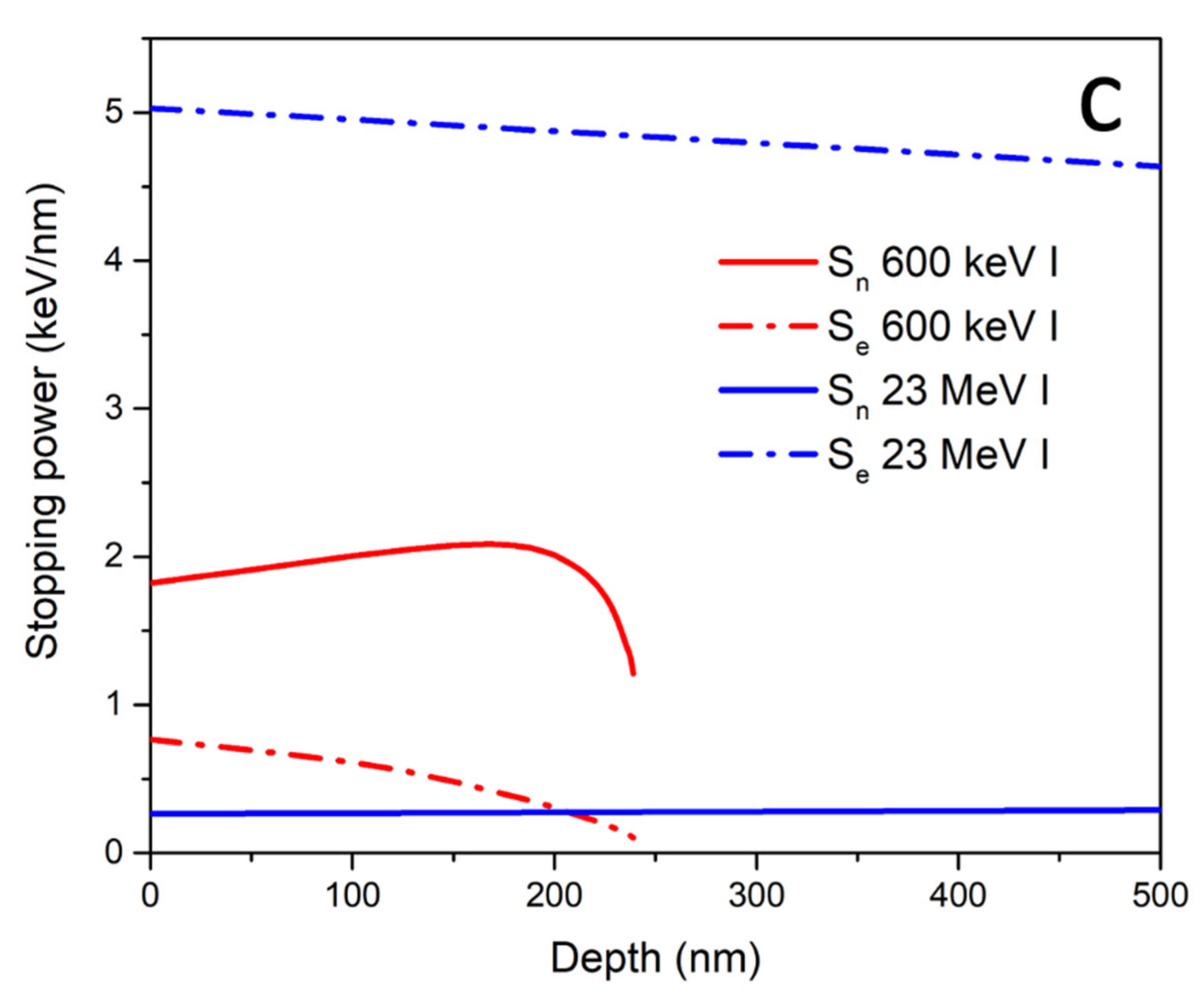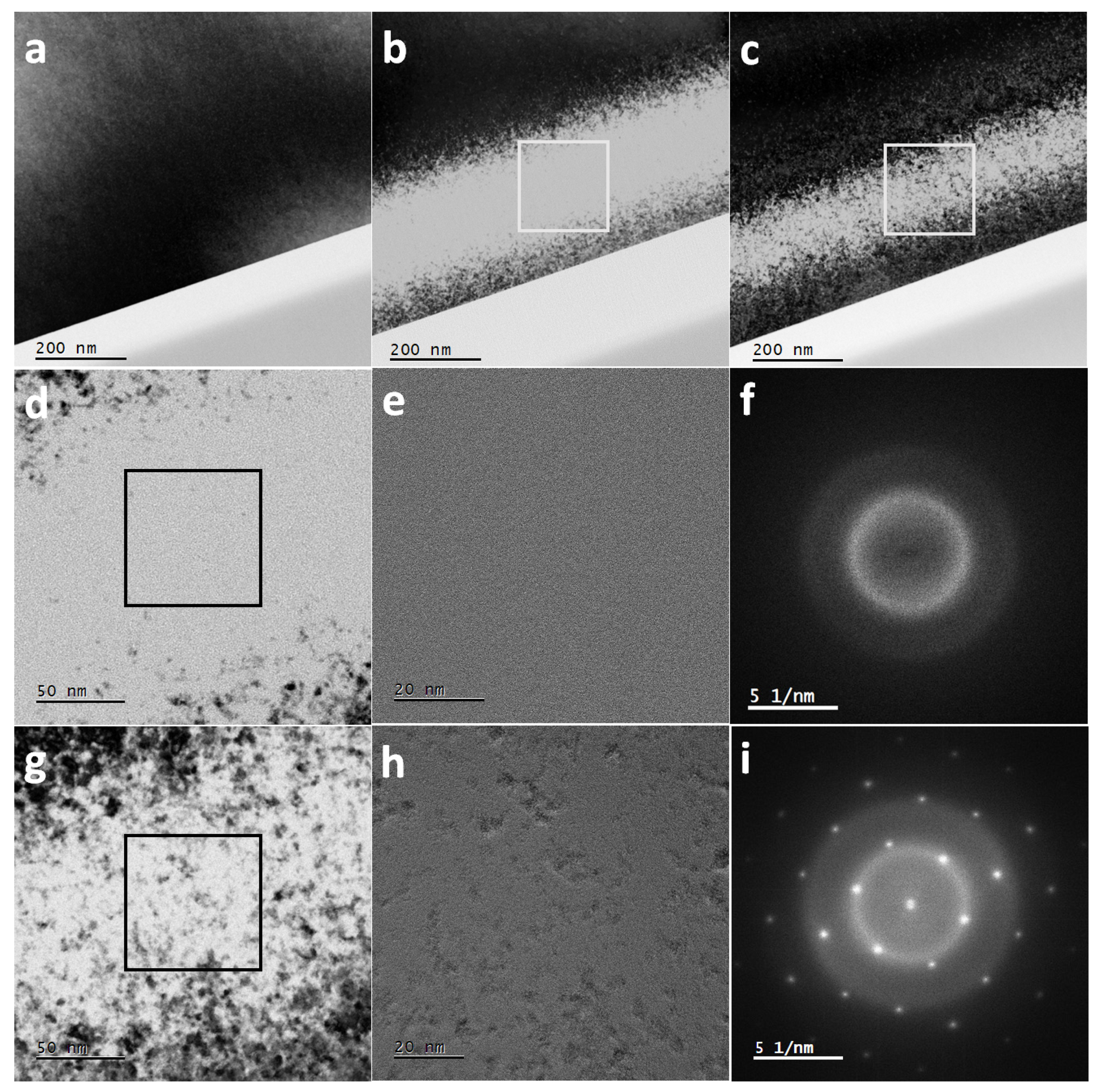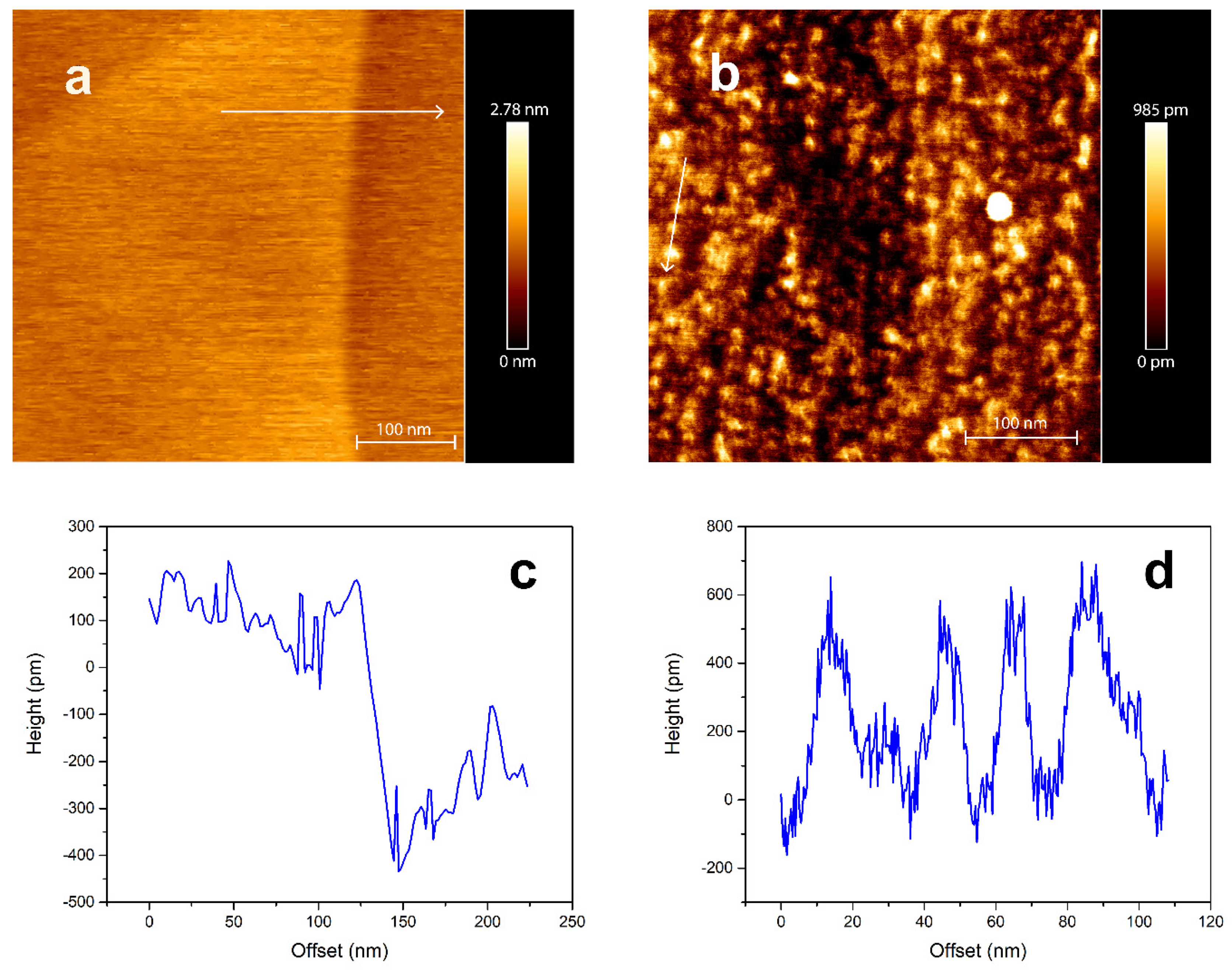Investigation of Ion Irradiation Effects in Silicon and Graphite Produced by 23 MeV I Beam
Abstract
1. Introduction
2. Experimental Methods
3. Results and Discussion
3.1. SHIBIEC Effect in Silicon
3.2. Ion Tracks in Graphite
4. Conclusions
Author Contributions
Funding
Institutional Review Board Statement
Informed Consent Statement
Data Availability Statement
Conflicts of Interest
References
- Bernas, H. (Ed.) Materials Science with Ion Beams; Springer: Berlin/Heidelberg, Germany, 2010. [Google Scholar]
- Karlušić, M.; Mičetić, M.; Kresić, M.; Jakšić, M.; Šantić, B.; Bogdanović-Radović, I.; Bernstorff, S.; Lebius, H.; Ban-d’Etat, B.; Žužek Rožman, K.; et al. Nanopatterning surfaces by grazing incidence swift heavy ion irradiation. Appl. Surf. Sci. 2021, 541, 148467. [Google Scholar] [CrossRef]
- Reed, R.A.; Vizkelethy, G.; Pellish, J.A.; Sierawski, B.; Warren, K.M.; Porter, M.; Wilkinson, J.; Marshall, P.W.; Niu, G.; Cressler, J.D.; et al. Applications of heavy ion microprobe for single event effects analysis. Nucl. Instr. Meth. Phys. Res. Sect. B 2007, 261, 443–446. [Google Scholar] [CrossRef]
- Baker, D.E. Graphite as a neutron moderator and reflector material. Nucl. Eng. Design 1971, 14, 413–444. [Google Scholar] [CrossRef]
- Toulemonde, M.; Assmann, W.; Dufour, C.; Meftah, A.; Studer, F.; Trautmann, C. Experimental Phenomena and Thermal Spike Model Description of Ion Tracks in Amorphisable Inorganic Insulators. Mat. Fys. Medd. Dan. Vid. Selsk. 2006, 52, 263–292. [Google Scholar]
- Williams, J.S. Materials modification with ion beams. Rep. Prog. Phys. 1986, 49, 491–587. [Google Scholar] [CrossRef]
- Toulemonde, M.; Weber, W.J.; Li, G.; Shutthanandan, V.; Kluth, P.; Yang, T.; Wang, Y.; Zhang, Y. Synergy of nuclear and electronic energy losses in ion-irradiation processes: The case of vitreous silicon dioxide. Phys. Rev. B 2011, 83, 054106. [Google Scholar] [CrossRef]
- Weber, W.J.; Zarkadoula, E.; Pakarinen, O.H.; Sachan, R.; Chisholm, M.F.; Liu, P.; Xue, H.; Jin, K.; Zhang, Y. Synergy of elastic and inelastic energy loss on ion track formation in SrTiO3. Sci. Rep. 2015, 5, 7726. [Google Scholar] [CrossRef]
- Zhang, Y.; Sachan, R.; Pakarinen, O.H.; Chisholm, M.F.; Liu, P.; Xue, H.; Weber, W.J. Ionization-induced annealing of pre-existing defects in silicon carbide. Nat. Commun. 2015, 5, 8049. [Google Scholar] [CrossRef]
- Dunlop, A.; Jaskierowicz, G.; Della-Negra, S. Latent track formation in silicon irradiated by 30 MeV fullerenes. Nucl. Instr. Meth. Phys. Res. Sect. B 1998, 146, 302–308. [Google Scholar] [CrossRef]
- Amekura, H.; Toulemonde, M.; Narumi, K.; Li, R.; Chiba, A.; Hirano, Y.; Yamada, K.; Yamamoto, S.; Ishikawa, N.; Okubo, N.; et al. Ion tracks in silicon formed by much lower energy deposition than the track formation threshold. Sci. Rep. 2021, 11, 185. [Google Scholar] [CrossRef]
- Sahoo, P.K.; Som, T.; Kanjilal, D.; Kulkarni, V.N. Swift heavy ion beam induced recrystallization of amorphous Si layers. Nucl. Instr. Meth. Phys. Res. Sect. B 2005, 240, 239–244. [Google Scholar] [CrossRef]
- Mihai, M.D.; Iordanescu, P.; Pantelica, D.; Petrascu, H.; Cracuin, D.; Cracuin, V.; Vasiliu, F.; Vasile, B.S.; Mercioniu, I. Annealing of preexisting defects in silicon single crystals by ion irradiation. Nucl. Instr. Meth. Phys. Res. Sect. B 2019, 450, 85–89. [Google Scholar] [CrossRef]
- Thomé, L.; Guttierez, G.; Monnet, I.; Garrido, F.; Debelle, A. Ionization-induced annealing in silicon upon dual-beam irradiation. J. Mat. Sci. 2020, 55, 5938. [Google Scholar] [CrossRef]
- Liu, J.; Neumann, R.; Trautmann, C.; Müller, C. Tracks of swift heavy ions in graphite studied by scanning tunneling microscopy. Phys. Rev. B 2001, 64, 184115. [Google Scholar] [CrossRef]
- Caron, M.; Rothard, H.; Toulemonde, M.; Gervais, B.; Beuve, M. Theoretical and experimental study of electronic temperatures in heavy ion tracks from Auger electron spectra and thermal spike calculations. Nucl. Instr. Meth. Phys. Res. Sect. B 2006, 245, 36–40. [Google Scholar] [CrossRef]
- Karlušić, M.; Jakšić, M. Thermal spike analysis of highly charged ion tracks. Nucl. Instr. Meth. Phys. Res. Sect. B 2012, 280, 103–110. [Google Scholar] [CrossRef]
- Zhai, P.; Liu, J.; Zeng, J.; Duan, J.; Xu, L.; Yao, H.; Guo, H.; Zhang, S.; Hou, M.; Sun, Y. Evidence for re-crystallization process in the irradiated graphite with heavy ions obtained by Raman spectroscopy. Carbon 2016, 101, 22–27. [Google Scholar] [CrossRef]
- Zhai, P.F.; Liu, J.; Duan, J.L.; Chang, H.L.; Zeng, J.; Hou, M.D.; Sun, Y.M. Velocity effect of swift heavy ions in graphite studied by Raman spectroscopy. Nucl. Instr. Meth. Phys. Res. Sect. B 2011, 269, 2035–2039. [Google Scholar] [CrossRef]
- Zeng, J.; Liu, J.; Yao, H.J.; Zhai, P.F.; Zhang, S.X.; Guo, H.; Hu, P.P.; Duan, J.L.; Mo, D.; Hou, M.D.; et al. Comparative study of irradiation effects in graphite and graphene. Carbon 2016, 100, 16–26. [Google Scholar] [CrossRef]
- Karlušić, M.; Fazinić, S.; Siketić, Z.; Tadić, T.; Cosic, D.D.; Božičević-Mihalić, I.; Zamboni, I.; Jakšić, M.; Schleberger, M. Monitoring ion track formation using in situ RBS/c, ToF-ERDA and HR-PIXE. Materials 2017, 10, 1041. [Google Scholar] [CrossRef] [PubMed]
- Karlušić, M.; Ghica, C.; Negrea, R.F.; Siketić, Z.; Jakšić, M.; Schleberger, M.; Fazinić, S. On the threshold for ion track formation in CaF2. New J. Phys. 2017, 19, 023023. [Google Scholar] [CrossRef]
- Ziegler, J.F.; Ziegler, M.D.; Biersack, J.P. SRIM—The stopping and range of the ions in matter (2010). Nucl. Instr. Meth. Phys. Res. Sect. B 2010, 268, 1818–1823. [Google Scholar] [CrossRef]
- Feldman, L.C.; Mayer, J.W.; Picraux, S.T. Materials Analysis by Ion Channeling: Submicron Crystallography; Academic Press Inc.: New York, NY, USA, 1982. [Google Scholar]
- Toulemonde, M.; Dufour, C.; Paumier, E. Transient thermal process after a high-energy heavy-ion irradiation of amorphous metals and semiconductors. Phys. Rev. B 1992, 46, 14362. [Google Scholar] [CrossRef]
- Bierschenk, T.; Giulian, R.; Afra, B.; Rodriguez, M.D.; Schauries, D.; Mudie, S.; Pakarinen, O.H.; Djurabekova, F.; Nordlund, K.; Osmani, O.; et al. Latent ion tracks in amorphous silicon. Phys. Rev. B 2013, 88, 174111. [Google Scholar] [CrossRef]
- Aumayr, F.; Facsko, S.; El-Said, A.S.; Trautmann, C.; Schleberger, M. Single ion induced surface nanostructures—A comparison between slow highly charged and swift heavy ions. J. Phys. Condens. Matter 2011, 23, 393001. [Google Scholar] [CrossRef]
- Elman, B.S.; Braunstein, G.; Dresselhaus, M.S.; Dresselhaus, G.; Venkatesan, T.; Wilkens, B. Channeling studies in graphite. J. Appl. Phys. 1984, 56, 2114–2119. [Google Scholar] [CrossRef]
- Venkatesan, T.; Elman, B.S.; Braunstein, G.; Dresselhaus, M.S.; Dresselhaus, G. Ion channeling studies of regrowth kinetics of disordered surface layers on graphite. J. Appl. Phys. 1984, 56, 3232–3240. [Google Scholar] [CrossRef]
- Meftah, A.; Brisard, F.; Constantini, J.M.; Hage-Ali, M.; Stoquert, J.P.; Studer, F.; Toulemonde, M. Swift heavy ions in magnetic insulators—A damage cross section velocity effect. Phys Rev. B 1993, 48, 920. [Google Scholar] [CrossRef]
- Rivera, A.; Olivares, J.; Crespillo, M.L.; García, G.; Bianconi, M.; Agulló-López, F. Assessment of swift-ion damage by RBS/c: Determination of the amorphization threshold. Nucl. Instr. Meth. Phys. Res. Sect. B 2009, 267, 1460–1463. [Google Scholar] [CrossRef]
- Jorio, A.; Lucchese, M.M.; Stavale, F.; Martins Ferreira, E.H.; Moutinho, M.V.O.; Capaz, R.B.; Achete, C.A. Raman study of ion-induced defects in N-layer graphene. J. Phys. Condens. Matter 2010, 22, 334204. [Google Scholar] [CrossRef]
- Toulemonde, M. Irradiation by swift heavy ions Influence of the non-equilibrium projectile charge state for near surface experiments. Nucl. Instr. Meth. Phys. Res. Sect. B 2006, 250, 263–268. [Google Scholar] [CrossRef]
- Ferrari, A.C.; Robertson, J. Interpretation of Raman spectra of disordered and amorphous carbon. Phys. Rev. B 2000, 61, 14095. [Google Scholar] [CrossRef]
- Eckmann, A.; Felten, A.; Mischenko, A.; Britnell, L.; Krupke, R.; Novoselov, K.S.; Casiraghi, C. Probing the Nature of Defects in Graphene by Raman Spectroscopy. Nano Lett. 2012, 12, 3925–3930. [Google Scholar] [CrossRef] [PubMed]
- Lang, M.; Lian, J.; Zhang, J.; Zhang, F.; Weber, W.J.; Trautmann, C.; Ewing, R.C. Single-ion tracks in Gd2Zr2−xTixO7 pyrochlores irradiated with swift heavy ions. Phys. Rev. B 2009, 79, 224105. [Google Scholar] [CrossRef]
- Meftah, A.; Brisard, F.; Constantini, J.M.; Dooryhee, E.; Hage-Ali, M.; Hervieu, M.; Stoquert, J.P.; Studer, F.; Toulemonde, M. Track formation in SiO2 quartz and the thermal-spike mechanism. Phys. Rev. B 1994, 49, 12457. [Google Scholar] [CrossRef]
- Dunlop, A.; Jaskierowicz, G.; Ossi, P.M.; Della-Negra, S. Transformation of graphite into nanodiamond following extreme electronic excitations. Phys. Rev. B 2007, 76, 155403. [Google Scholar] [CrossRef]
- Peng, H.B.; Lu, X.; Cheng, R.; Wang, Q.; Zhao, Y.T.; Yuan, W.; Yang, K.J.; Wang, T.S. Formation of monolayer graphene on a basal HOPG surface irradiated with Xe ions. Nucl. Instr. Meth. Phys. Res. Sect. B 2013, 307, 127–130. [Google Scholar] [CrossRef]
- Akcöltekin, S.; Akcöltekin, E.; Schleberger, M.; Lebius, H. Scanning probe microscopy investigation of nanostructured surfaces induced by swift heavy ions. J. Vac. Sci. Technol. B 2009, 27, 944–947. [Google Scholar] [CrossRef]
- Akcöltekin, E.; Peters, T.; Meyer, R.; Duvenbeck, A.; Klusmann, B.; Monnet, I.; Lebius, H.; Schleberger, M. Creation of multiple nanodots by single ions. Nat. Nanotech. 2007, 2, 290–294. [Google Scholar] [CrossRef]
- Akcöltekin, S.; Akcöltekin, E.; Roll, T.; Lebius, H.; Schleberger, M. Patterning of insulating surfaces by electronic excitation. Nucl. Instr. Meth. Phys. Res. Sect. B 2009, 267, 1386–1389. [Google Scholar] [CrossRef]
- Karlušić, M.; Akcöltekin, S.; Osmani, O.; Monnet, I.; Lebius, H.; Jakšić, H.; Schleberger, M. Energy threshold for the creation of nanodots on SrTiO3 by swift heavy ions. New J. Phys. 2010, 12, 043009. [Google Scholar] [CrossRef]
- Karlušić, M.; Kozubek, R.; Lebius, H.; Ban-d’Etat, B.; Wilhelm, R.A.; Buljan, M.; Siketić, Z.; Scholz, F.; Meisch, T.; Jakšić, M.; et al. Response of GaN to energetic ion irradiation—Conditions for ion track formation. J. Phys. D Appl. Phys. 2015, 48, 325304. [Google Scholar] [CrossRef]
- Karlušić, M.; Bernstorff, S.; Siketić, Z.; Šantić, B.; Bogdanović-Radović, I.; Jakšić, M.; Schleberger, M.; Buljan, M. Formation of swift heavy ion tracks on rutile TiO2 (001) surface. J. Appl. Cryst. 2016, 49, 1704–1712. [Google Scholar] [CrossRef]
- Karlušić, M.; Jakšić, M.; Lebius, H.; Ban-d’Etat, B.; Wilhelm, R.A.; Heller, R.; Schleberger, M. Swift heavy ion track formation in SrTiO3 and TiO2 under randon, channeling and near-channeling conditions. J. Phys. D Appl. Phys. 2017, 50, 205302. [Google Scholar] [CrossRef]
- Rymzhanov, R.A.; Medvedev, N.; O’Connell, J.H.; van Vuuren, A.J.; Skuratov, V.A.; Volkov, A.E. Recrystallization as the governing mechanism of ion track formation. Sci. Rep. 2019, 9, 3837. [Google Scholar] [CrossRef] [PubMed]
- Osmani, O.; Alzaher, I.; Peters, T.; d’Etat, B.B.; Cassimi, A.; Lebius, H.; Monnet, I.; Medvedev, N.; Rethfeld, B.; Schleberger, M. Damage in crystalline silicon by swift heavy ion irradiation. Nucl. Instr. Meth. Phys. Res. Sect. B 2012, 282, 43–47. [Google Scholar] [CrossRef]






| Material | Ion Beam | Sn/dx (keV/nm) | Se/dx (keV/nm) | R (μm) |
|---|---|---|---|---|
| silicon | 600 keV iodine | 1.82 | 0.77 | 0.23 |
| 23 MeV iodine | 0.26 | 5.03 | 6.81 | |
| 1 MeV protons | 0 | 0.04 | 16.34 | |
| HOPG | 23 MeV iodine | 0.27 | 6.72 | 5.56 |
| 1 MeV protons | 0 | 0.05 | 12.37 |
Publisher’s Note: MDPI stays neutral with regard to jurisdictional claims in published maps and institutional affiliations. |
© 2021 by the authors. Licensee MDPI, Basel, Switzerland. This article is an open access article distributed under the terms and conditions of the Creative Commons Attribution (CC BY) license (https://creativecommons.org/licenses/by/4.0/).
Share and Cite
Tomić Luketić, K.; Karlušić, M.; Gajović, A.; Fazinić, S.; O’Connell, J.H.; Pielić, B.; Radatović, B.; Kralj, M. Investigation of Ion Irradiation Effects in Silicon and Graphite Produced by 23 MeV I Beam. Materials 2021, 14, 1904. https://doi.org/10.3390/ma14081904
Tomić Luketić K, Karlušić M, Gajović A, Fazinić S, O’Connell JH, Pielić B, Radatović B, Kralj M. Investigation of Ion Irradiation Effects in Silicon and Graphite Produced by 23 MeV I Beam. Materials. 2021; 14(8):1904. https://doi.org/10.3390/ma14081904
Chicago/Turabian StyleTomić Luketić, Kristina, Marko Karlušić, Andreja Gajović, Stjepko Fazinić, Jacques H. O’Connell, Borna Pielić, Borna Radatović, and Marko Kralj. 2021. "Investigation of Ion Irradiation Effects in Silicon and Graphite Produced by 23 MeV I Beam" Materials 14, no. 8: 1904. https://doi.org/10.3390/ma14081904
APA StyleTomić Luketić, K., Karlušić, M., Gajović, A., Fazinić, S., O’Connell, J. H., Pielić, B., Radatović, B., & Kralj, M. (2021). Investigation of Ion Irradiation Effects in Silicon and Graphite Produced by 23 MeV I Beam. Materials, 14(8), 1904. https://doi.org/10.3390/ma14081904







